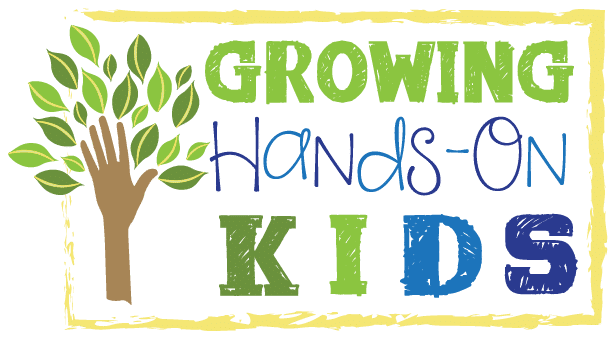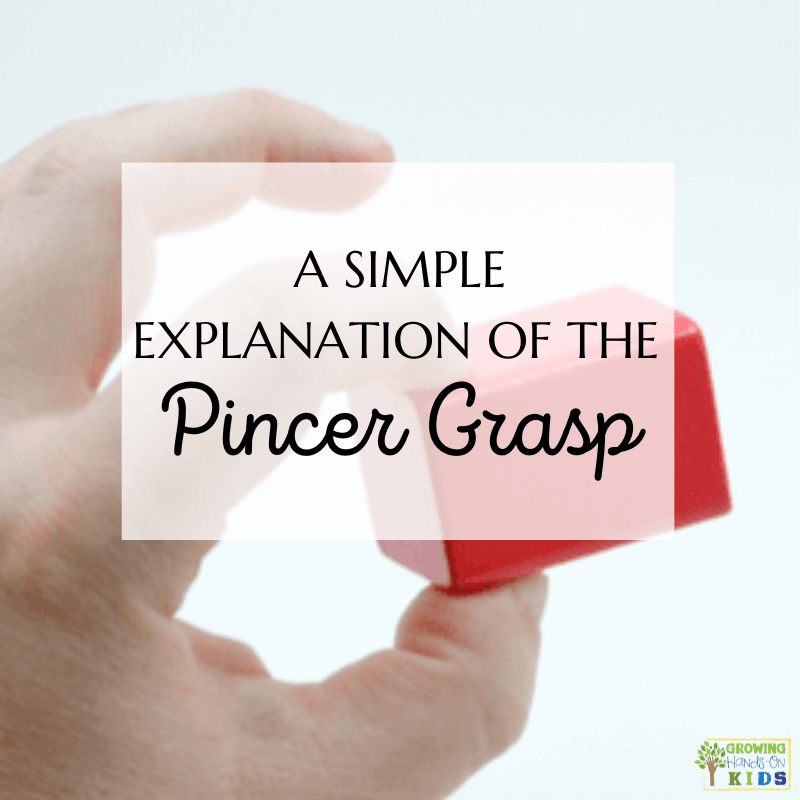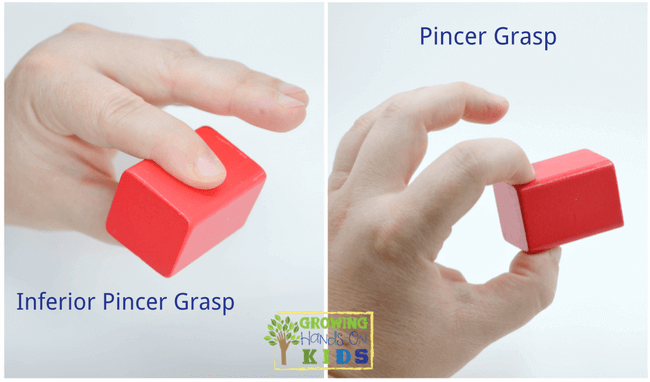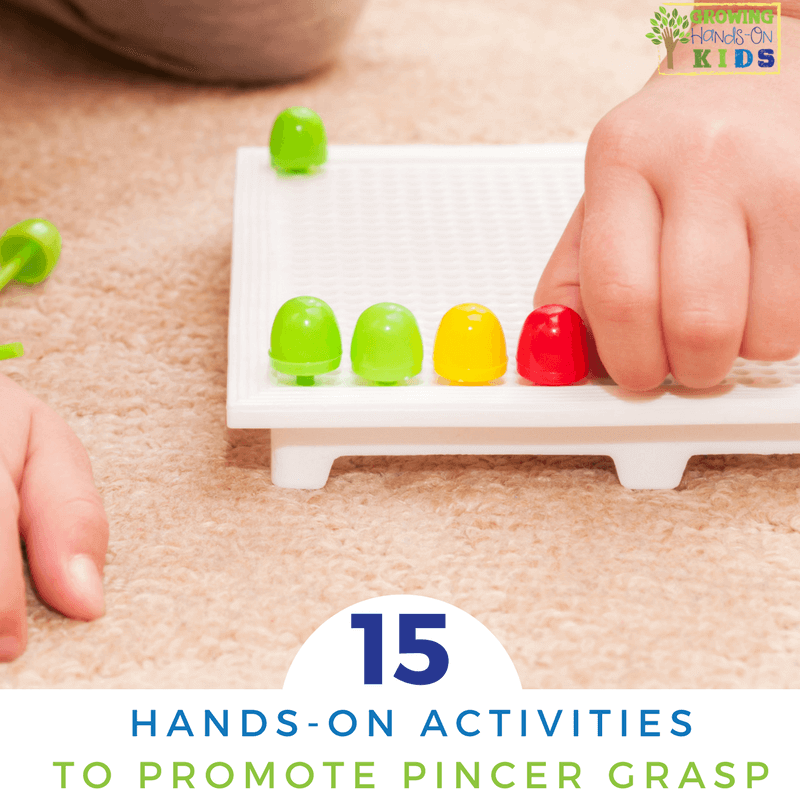What is a Pincer Grasp?
Affiliate and Referral links are used below to promote products I love and recommend. I receive a commission on any purchases made through these links. Please see my disclosure policy for more details. As an Amazon Associate, I earn from qualifying purchases.
Today we are going to take a look at a common grasp that emerges as a baby begins to grasp objects with their hands. Have you ever wondered what is a pincer grasp and why it matters? If so, I have all the answers for you in this post.
Pincer Grasp Table of contents
The pincer grasp is an essential skill for childhood development. Keep reading to learn more about what it is and when it develops.
Pincer Grasp Definition
The pincer grasp is defined as a grasp that uses the pads and then tips of the index finger and thumb to pick up and grasp objects. Lots of developmental skills need to be in place for a baby to master the pincer grasp such as core and should stability.
You probably recognize this grasp the most as a baby starts feeding itself and can pick up smaller pieces of food such as circle cereal with their fingers instead of the palm of their hand.
You will also see it referred to as a neat pincer grasp or superior pincer grasp.
Pincer Grasp Development
When a baby begins to develop grasp patterns, it begins with very crude movements that involve the entire arm or hand. Babies develop by focusing on large movement patterns first, such as rolling, sitting, up, and cruising/crawling. All of these are important for a baby as they begin to refine grasp patterns. They need to be able to hold themselves up and stabilize the arm as they reach refined grasp movements and patterns.
The pincer grasp is also important for future handwriting skills like pencil grasp. We will look at ways you can work with older children on pincer grasp below.
Inferior Pincer Grasp
An inferior pincer grasp is similar to a regular pincer grasp, except that the child is still learning to master this grasp and so they use the pads of the fingers instead of the tips. You will most likely notice this grasp as a baby begins to pick up finger foods or smaller objects. The 3rd finger or pointer finger may also be used to help support.
You will also see it referred to as a crude pincer grasp.
Neat Pincer Grasp
The neat pincer grasp is when the tips of the thumb and index finger are used to grasp objects. The neat pincer grasp allows for more precise movement and develops between 10 and 12 months old.
You may also see this referred to as a superior pincer grasp or just a pincer grip. I prefer using the term pincer grasp so as not to confuse later on with pencil grip tools that are sometimes used to support handwriting.
At what age does the pincer grasp develop?
The inferior pincer grasp will develop around 8 to 9 months old with the neat pincer grasp refined around 10-12 months of age. This is when a baby begins to grasp smaller objects such as finger foods and needs a more precise grasp in order to be successful.
The pincer grasp is also needed as a child begins to grasp a pencil for handwriting and other functional skills such as dressing and pinching objects as a child matures to 3 to 5 years old.
When a child is 5 to 10 years old you will notice their grasp and grip strengthening as they are able to open or hold heavier objects and be able to grade the strength needed for various everyday tasks.
Pincer Grasp Activities for Baby
Here are some very simple activities that you can provide to your baby to promote good pincer grasp skills. Many typical fine motor skills are great for encouraging a good pincer grip on items.
You can also check out my post on fine motor development to see what is appropriate for infants to 18 months to be working on and mastering.
For this age, we also want to be careful of small objects, so all of these ideas need to be supervised, but I also used items that are larger to help prevent choking hazards.
- Play with blocks – you can read my developmental activities with blocks
- Turning pages of a book – start with board books and gradually introduce books with thinner pages
- Finger foods – introduce a variety of shapes and textures when your baby is ready for them such as cheerios, long pieces of fruit or vegetables, or anything that encourages self-feeding. This can also include introducing utensils for eating
- Water play – dumping and pouring with spoons, ladles, or containers
- Pulling tissues out of a tissue box
- Pushing large buttons through a container lid or dropping objects into a container
- Large puzzles with handles or knobs
- Any toy with large knobs/dials to turn or flip
- Stacking rings
- Using tongs or scoops for sensory play
- Any activity or toy that promotes squeezing or pinching movements
- Rock crayons for coloring
Pincer Grasp Activities for Toddlers
I'm defining the toddler age as 18 months to 35 months old, or almost 3 years old. A toddler can continue to master pincer grip through a variety of activities.
I also have a separate post if you are curious about what fine motor skills toddlers are mastering.
- Transferring large pom-poms with fingers or tongs
- Eating finger foods such as fruit, vegetables, cereals, puffs, etc
- Removing or placing pegs or rings to and from a pegboard
- Stringing large beads
- Scribbling and marking pre-writing lines on paper using small crayons
- Lacing cards
- Stacking blocks
- Playing with clay or play dough
- Using large clothespins to transfer objects
- Using cotton balls for a craft or in a sensory bin
Pincer Grasp Activities for Kids
Babies aren't the only ones who need to practice pincer grasp. As we talked about earlier, it is an important grasp for future pencil grasp skills so a child is able to hold the pencil between the tips of the thumb and index finger for a tripod grasp, or an additional middle finger for the quadrupod grasp.
You can also check out these developmental milestones for fine motor skills for ages 0-6 to get more ideas.
- Play board games (Operation, Guess Who, Monopoly, etc)
- Play card games
- Playing with play dough (calming play dough recipe here)
- Stringing beads
- Search and find sensory play activities (slime, rice bins, oatmeal bins, etc)
- Peeling stickers
- Using clothespins in a game or activity
- Eye droppers to transfer water
- Lacing cards
- Crocheting
- Playing with marbles or jacks
References:
Case-Smith, J. O'Brien, J.C. Occupational Therapy for Children and Adolescents, 7th Edition. 2015. Mosby, an imprint of Elsevier Inc.
Hirschel, A., Pehoski, C., Coryell, J.; Environmental Support and the Development of Grasp in Infants. Am J Occup Ther August 1990, Vol. 44(8), 721–727. doi: https://doi.org/10.5014/ajot.44.8.721
Maheswari, S. When Will Your Baby Develop the Pincer Grasp? March 2019. Mom Junction. Retrieved on 4/14/2019 from https://www.momjunction.com/articles/when-will-your-baby-develop-the-pincer-grasp_00327049/#gref
You May Also Like:

Heather Greutman, COTA
Heather Greutman is a Certified Occupational Therapy Assistant with experience in school-based OT services for preschool through high school. She uses her background to share child development tips, tools, and strategies for parents, educators, and therapists. She is the author of many ebooks including The Basics of Fine Motor Skills, and Basics of Pre-Writing Skills, and co-author of Sensory Processing Explained: A Handbook for Parents and Educators.



